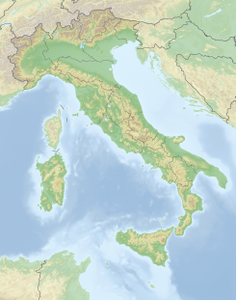Isola Madre
| Isola Madre | ||
|---|---|---|
| Isola Madre | ||
| Waters | Lake Maggiore | |
| Archipelago | Borromean Islands | |
| Geographical location | 45 ° 54 '40 " N , 8 ° 32' 16" E | |
|
|
||
| length | 330 m | |
| width | 220 m | |
| surface | 59 ha | |
| Residents | uninhabited | |
The Isola Madre (German: Mother Island ) is one of the Borromean Islands and is the largest island in Lake Maggiore . The entire island (220 meters wide and 330 meters long) is covered by a historical building ensemble and a park, the Palazzo Madre. Originally the island was called Isola di San Vittore (German: St. Viktor Island ) and later Isola Maggiore (German: Big Island ). The island belongs to the municipality of Stresa .
history
Historical sources mention a church on the island in the 9th century, which was consecrated to St. Viktor (probably an offshoot of the parish church of Verbania ), as well as a cemetery. The existence of a military fortification from this period - similar to that of the San Angelo Castle on Isolino San Giovanni - cannot be ruled out, but cannot be proven archaeologically. What is certain is that at that time olive oil was extracted on the island for sacred purposes.
From 1501 Lancilotto Borromeo , one of the five sons of Giovanni III Borromeo and Cleofe Pio di Carpi, began growing citrus fruits on the island , which he had brought from Liguria together with a gardener ("hortolano") . He also ordered the construction of a manor house, which was to become the core of the palace complex, which was expanded in the Renaissance style from 1580 under Renato I Borromeo . During these years, a dynasty of gardeners hortolani , the Della Torre family , established themselves on Isola Madre until the beginning of the 19th century.
From around 1823 to 1825, Giacomo and Francesco Rovelli, horticulturalists from Monza , converted the cultivated parts of the island into a landscape garden in the English style and thus also preserved the originally preserved forest in the northwest of the island. This happened at the suggestion of Counts Giberto V Borromeo and Vitaliano IX Borromeo Arese . The English Garden on Isola Madre is considered an outstanding example of horticultural art in Italy.
Buildings
- Palazzo Madre (built in the 16th to 18th centuries on the remains of the original church, the cemetery and (presumably) a fort)
- Family chapel from 1858 (which, unlike the church on Isola Bella, does not contain any tombs)
- English-style landscaped garden covering almost eight hectares, built on a citrus grove; famous is the “Totenstiege” ( scala dei morti ), probably named after the island's cemetery, which has been adorned with an important collection of wisteria over the past few decades .
Today's meaning
The Isola Madre now serves as a sight and museum, the palace is no longer inhabited. The island can be reached by boat, from Stresa a regular service operates the route Stresa-Isola Bella-Isola Madre- Isola dei Pescatori- Stresa.
photos
Web links
- Isola Madre: a fairytale botanical garden on Lake Maggiore
- Isole Borromee on isoleborromee.it/ger
- Isole Borromee (Italian)
- Isola Madre on the ETHorama platform





